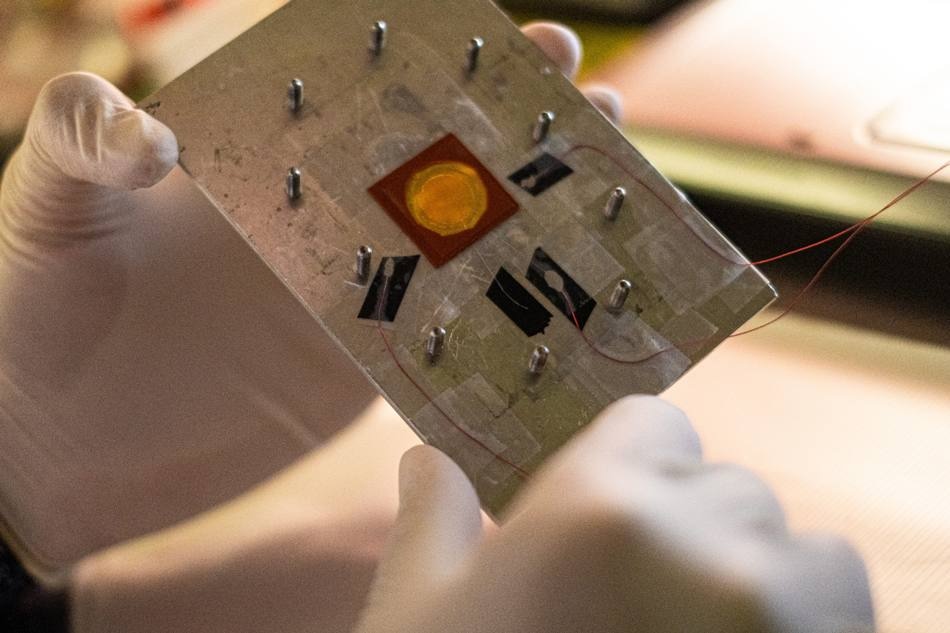Oct 15 2019
Researchers at Rice University have discovered revealing information where light from a molecule encounters light from a nanoparticle.
 Rice chemists amplify the light from small concentrations of molecules on a surface by maximizing the spectral overlap between the emission and the plasmon resonance of adjacent nanoparticles. The glowing molecules can be clearly seen with the naked eye when excited. (Image credit: Jeff Fitlow)
Rice chemists amplify the light from small concentrations of molecules on a surface by maximizing the spectral overlap between the emission and the plasmon resonance of adjacent nanoparticles. The glowing molecules can be clearly seen with the naked eye when excited. (Image credit: Jeff Fitlow)
The labs of Rice chemists Christy Landes and Stephan Link showed how to enhance a technique for sensing small concentrations of molecules by intensifying the light they release when their spectral frequencies intersect with those of adjacent plasmonic nanoparticles.
The surface plasmons—coherent electron waves that ripple across the surface of a metallic nanoparticle—serve as antennas and improve the light emitted by the molecules by up to 10 times when they are in the “sweet spot” close to a particle.
Their method is the subject of a paper published in a special edition of the Journal of Chemical Physics highlighting emerging paths in plasmonics. The Rice project could help scientists examine the active surfaces of catalysts and other materials at the nanoscale, a vital step toward optimizing their efficiency.
According to Thomas Heiderscheit, a Rice graduate student and the lead author of the paper, the discovery depends on the occurrence of electrochemiluminescence (ECL), by which electricity stimulates chemical reactions that trigger molecules to produce light. It is usually used to find out trace materials like the Zika virus in biological fluids or heavy metals in water.
Earlier studies concluded that spectral overlap of the molecules and nanoparticle would improve the signal. However, those studies could not explain the inherent variations in nanoparticle shapes and sizes that could cover the effects. The Rice scientists had aimed to lessen these other impacts to concentrate only on the impact of spectral frequency overlap on signal augmentation.
This study looks at what type of antenna is the best to use, because the properties of the nanoparticle dictate the spectrum and its overlap with the molecule. Should it be round or should it have sharp edges? Should it be smaller or larger?
Miranda Gallagher, Postdoctoral Research Associate and Study Co-Author, Rice University
In the experiments, the team integrated either gold nanospheres or sharp-tipped gold nanotriangles with a ruthenium-based dye molecule in a polymer shell that prevented the molecules from traveling very far from the particles.
That’s essentially our electrode. If we didn’t have the polymer, the dye molecules would be free to move and we’d see light diffused across the sample.
Thomas Heiderscheit, Graduate Student and Study Lead Author, Rice University
Since the molecules were inhibited by the polymer, they could clearly observe molecules emitting near particles. They established that signal augmentation is governed by a combination of size and frequency matching between the nanospheres and the dye molecule, and just frequency matching for nanotriangles.
Heiderscheit stated that single-molecule imaging is still a stretch for the emerging method.
“Essentially, we’re imaging how active a surface is,” he said. “The Department of Energy (the main sponsor of the project) cares about this research because it could achieve super-resolution mapping of reactivity on a surface.” Super-resolution allows the capture of images lower than the diffraction limit of light.
For instance, if you have nanoparticles in a battery system, you can use ECL to map where the reactions are most chemically active. You’re essentially determining what nanoparticles make a good catalyst, and we can use this tool to design better ones.
Thomas Heiderscheit, Graduate Student and Study Lead Author, Rice University
The paper’s co-authors include Rice graduate students Rashad Baiyasi, Seyyed Ali Hosseini Jebeli, Alexander Al-Zubeidi, and Charlotte Flatebo; postdoctoral fellow Sean Collins; and Rice alumni Leonardo Scarabelli and Wei-Shun Chang.
Link is a professor of chemistry and of electrical and computer engineering. Landes is a professor of chemistry, of electrical and computer engineering, and of chemical and biomolecular engineering.
The study received support from the Department of Energy’s Office of Science, Basic Energy Sciences; the Robert A. Welch Foundation; and Rice’s Smalley-Curl Institute.